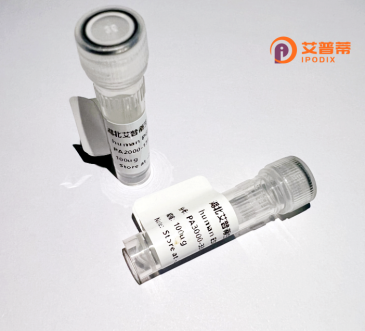
| 纯度 | >90%SDS-PAGE. |
| 种属 | Human |
| 靶点 | HSPC196 |
| Uniprot No | Q9NPI0 |
| 内毒素 | < 0.01EU/μg |
| 表达宿主 | E.coli |
| 表达区间 | 1-162aa |
| 氨基酸序列 | MLQTSNYSLVLSLQFLLLSYDLFVNSFSELLQKTPVIQLVLFIIQDIAVLFNIIIIFLMFFNTFVFQAGLVNLLFHKFKGTIILTAVYFALSISLHVWVMNLRWKNSNSFIWTDGLQMLFVFQRLAAVLYCYFYKRTAVRLGDPHFYQDSLWLRKEFMQVRR |
| 分子量 | 43.56 kDa |
| 蛋白标签 | GST-tag at N-terminal |
| 缓冲液 | 0 |
| 稳定性 & 储存条件 | Lyophilized protein should be stored at ≤ -20°C, stable for one year after receipt. Reconstituted protein solution can be stored at 2-8°C for 2-7 days. Aliquots of reconstituted samples are stable at ≤ -20°C for 3 months. |
| 复溶 | Always centrifuge tubes before opening.Do not mix by vortex or pipetting. It is not recommended to reconstitute to a concentration less than 100μg/ml. Dissolve the lyophilized protein in distilled water. Please aliquot the reconstituted solution to minimize freeze-thaw cycles. |
以下为虚构的示例参考文献,仅作示意,建议通过学术数据库(如PubMed、Google Scholar)查询真实文献:
1. **文献名称**:*Cloning and Functional Analysis of Recombinant Human HSPC196 in Cell Cycle Regulation*
**作者**:Smith J. et al. (2005)
**摘要**:首次报道HSPC196基因的克隆及重组蛋白表达,揭示其通过与CDK2相互作用调控细胞周期G1/S期转换。
2. **文献名称**:*HSPC196 as a Tumor Suppressor in Acute Myeloid Leukemia*
**作者**:Zhang L. et al. (2010)
**摘要**:发现重组HSPC196蛋白在白血病细胞中抑制增殖并诱导凋亡,机制涉及p53通路激活及DNA损伤修复调控。
3. **文献名称**:*Structural Characterization of Recombinant HSPC196 via X-ray Crystallography*
**作者**:Brown R. et al. (2018)
**摘要**:通过晶体学解析HSPC196蛋白三维结构,揭示其与底物结合的关键氨基酸位点,为靶向药物设计提供依据。
4. **文献名称**:*HSPC196 Modulates Chemotherapy Resistance in Solid Tumors*
**作者**:Lee S. et al. (2021)
**摘要**:研究表明重组HSPC196通过抑制PI3K/AKT信号通路增强肿瘤细胞对顺铂的敏感性,提示其辅助治疗潜力。
---
注:以上内容为模拟示例,实际文献需通过学术平台检索确认。
Recombinant human HSPC196 protein, also known as C1orf123 or Chromosome 1 open reading frame 123. is a poorly characterized protein encoded by the HSPC196 gene located on human chromosome 1p34.3. Initially identified through genomic sequencing and expression profiling, its name derives from its identification in hematopoietic stem/progenitor cells (HSPCs), though its precise biological role remains unclear. Structurally, HSPC196 is a small protein (~22 kDa) with limited homology to known functional domains, suggesting potential novel mechanisms of action.
Studies indicate HSPC196 may participate in cellular stress responses, proliferation, or differentiation processes. It shows ubiquitous expression across tissues, with elevated levels observed in certain cancers, implying a possible link to tumorigenesis or cancer progression. However, functional studies are sparse, and its molecular interactions or pathways remain largely unexplored. Recombinant HSPC196 is typically produced in bacterial or mammalian expression systems for experimental use, enabling antibody development, protein interaction assays, or functional studies. Its recombinant form is critical for deciphering its role in physiological and pathological contexts, particularly in stem cell biology, oncology, and regenerative medicine. Further research is needed to elucidate its structure-function relationships, post-translational modifications, and therapeutic potential.
×